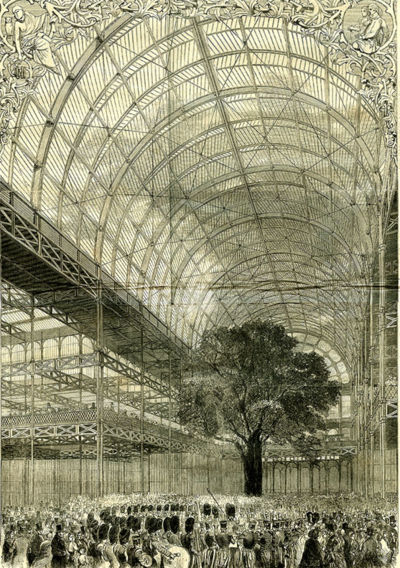Crystal Palace: Difference between revisions
imported>Russell Potter (image resize) |
imported>Russell Potter (adding more info) |
||
| Line 1: | Line 1: | ||
[[Image:Cpal lastprom.jpg|thumb|right|400px|"Last Promenade at the Crystal Palace" 1852. Note the tree completely enclosed by the Palace structure]] | [[Image:Cpal lastprom.jpg|thumb|right|400px|"Last Promenade at the Crystal Palace" 1852. Note the tree completely enclosed by the Palace structure]] | ||
The '''Crystal Palace''' was built to house the [[Great Exhibition of the Industry of All Nations]] in [[Hyde Park]], [[London]], in 1851. After the Exhibition, it was moved and expanded and rebuilt on [[Sydenham]] Hill overlooking London, where it enjoyed a second life from 1854 until its destruction in a horrific fire in 1936. | The '''Crystal Palace''' was built to house the [[Great Exhibition of the Industry of All Nations]] in [[Hyde Park]], [[London]], in 1851. After the Exhibition, it was moved and expanded and rebuilt on [[Sydenham]] Hill overlooking London, where it enjoyed a second life from 1854 until its destruction in a horrific fire in 1936. | ||
The Crystal Palace is a significant structure in many ways; it was the first structure of its size assembled out of [[prefabricated parts]]; its system of horizontal trusses has since become one of the most widely-used construction methods in the world; it was at the time the world's largest enclosed open-air structure; and its success inspired the building of similar structures around the world, from the [[New York Crystal Palace]] in [[New York City]] to the [[Kibble Palace]] in [[Glasgow]]. It also has enormous historical and cultural significance as a symbol of technological prowess and imperial power, and in its second incarnation in Sydenham as a [[suburbs|suburban]] pleasure palace drawing crowds away from the central metropolis. While at Sydenham, it also served as a concert hall, famous for its performances of Handel with a massed orchestra, choir, and the Palace's enormous organ; a recording of such a performance in 1888 is the earliest known recording of live music in exsitence. Its exterior parks, with fountains, terraces, and an outdoor exhibition of life-size [[dinosaur]] sculptures, was also highly influential. It also housed, from 1933 to 1936, the experimental studios of the [[John Logie Baird|Baird]] television company, which made regular [short-wave]] broadcasts from its South Tower. | |||
Revision as of 10:39, 3 June 2007
The Crystal Palace was built to house the Great Exhibition of the Industry of All Nations in Hyde Park, London, in 1851. After the Exhibition, it was moved and expanded and rebuilt on Sydenham Hill overlooking London, where it enjoyed a second life from 1854 until its destruction in a horrific fire in 1936.
The Crystal Palace is a significant structure in many ways; it was the first structure of its size assembled out of prefabricated parts; its system of horizontal trusses has since become one of the most widely-used construction methods in the world; it was at the time the world's largest enclosed open-air structure; and its success inspired the building of similar structures around the world, from the New York Crystal Palace in New York City to the Kibble Palace in Glasgow. It also has enormous historical and cultural significance as a symbol of technological prowess and imperial power, and in its second incarnation in Sydenham as a suburban pleasure palace drawing crowds away from the central metropolis. While at Sydenham, it also served as a concert hall, famous for its performances of Handel with a massed orchestra, choir, and the Palace's enormous organ; a recording of such a performance in 1888 is the earliest known recording of live music in exsitence. Its exterior parks, with fountains, terraces, and an outdoor exhibition of life-size dinosaur sculptures, was also highly influential. It also housed, from 1933 to 1936, the experimental studios of the Baird television company, which made regular [short-wave]] broadcasts from its South Tower.
